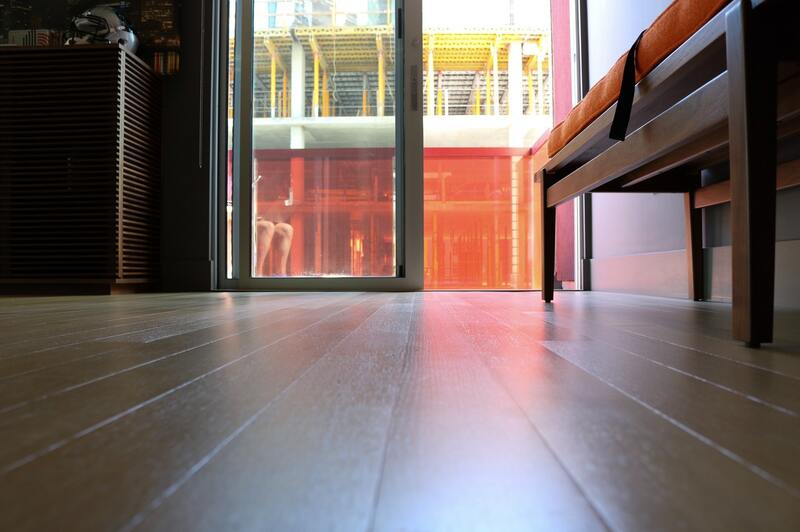Wooden floors start looking worn after several years; it’s essential to learn how to scrape water damaged floors. Scraping can help restore the original beauty of your hardwood floor.
You will need special scrapers or sandpaper for this D.I.Y. project. You may also ask the help of a professional if there’s substantial damage.

Signs Of Water Damage
Hardwood floors get water damage from leaks, spills, or floods. Homeowners must learn how to identify the signs of water damage and fix the source before they start scraping.
Here’s how to know you have a water damaged floor:
1. Warping
You may notice some disfigurement on your floor. Peeling, bubbling, or cracking means too much moisture buildup on the surface.
2. Odor
Moisture buildup leads to rot and mold, which cause a musky odor. If you start smelling something unusual on your floor, there is water damage.
3. Crowning
Floors shrink on the underside when they lose moisture, so you may notice the planks becoming rounded.
4. Cupping
This sign is the opposite of crowning; your floor planks will curl upward when the underside absorbs moisture. The planks bulge at the side with a hollow center.
5. Buckling
When your floor buckles, it becomes detached from the subfloor. You will have planks peeling upwards, making it difficult to walk on the surface.
6. Discoloration
Dark spots or stains on your wood may be signs of mold growth. Mold means there’s too much moisture on your wooden floor.
Step-By-Step Process How To Scrape Your Wooden Floor
Hand scraping is one way to fix water damage on wooden floors. It will remove stains and the damaged layer, and your floor will look refurbished after polishing.
There are alternative ways to fix your floor too. Here are some ways how to fix water damaged hardwood floors.
Step #1. Prepare your materials
You may use sandpaper to scrape your floors, but specialty scrapers can do better. Here are the other materials you will need for your project:
- Sander
- Extra blades for your scrapers
- Applicator or brush
- Varnishing oil
- Protective equipment like gloves and knee pads
Step #2. Start scraping the floor
Use your tools to scrape the floor in line with the boards. Continue this from wall to wall until you reach the other end of the room.
Step #3. Change blades and finish the whole floor
If you feel less resistance on your scraper, you need to change the blade. Continue scraping until the wood is bare and isn’t shiny anymore.
Step #4. Start sanding
Some parts of the wood finish are too stubborn to remove with a hand-held scraper. You may pass your sander over the surface once to remove those bits.
Step #5. Apply wood varnish
Once you’ve scraped the whole floor, you can apply wood varnish. Use your applicator to apply one coat, then apply the second coat after 24 hours.
Once you’ve finished these steps, your floor will look new again, and there won’t be any signs of the previous water damage.
However, scraping can’t fix bulging floors, so here is a guide on how to flatten water damaged floor.
A Damaged Subfloor
The subfloor is the concrete or wooden part under your main floor. It supports your home’s structure and adds an extra protective layer from the ground.
Sometimes, excessive water damage can affect your subfloor, making it moldy and warped. You may repair the damage if it only happens in small areas, but you need to replace the whole floor if it’s too large.
Flooding usually causes this extensive damage to your floor. Dry the area once you see it’s exposed to water.
You can ask the help of a professional if the damage is too large. Your floors will need renovation.
How To Maintain Your Wooden Floor
After all the repairs and renovations, you must make an effort to maintain your floor’s good condition. Here are the best ways you can do that.
1. Use rugs or carpets
Rugs and carpets can protect your floor from spills or scratches. Put some in the heavy traffic areas for added padding.
2. Do spot cleaning
Wipe all spills as soon as you spot them to prevent the damage from becoming more severe.
3. Do regular cleaning
Spot cleaning can help stains, but regular cleaning can protect your floor from more severe issues. There will be less rot and mold when your floor is clean.
4. Try deep cleaning
Professionals will always do the best work, so it’s best to periodically hire a cleaner for your floors.
5. Be gentle
Scratching your floor can form crevices where water will get stuck. Be careful when you’re moving heavy or sharp objects.
Take precautions when moving heavy furniture, and ask guests to be mindful when using hard shoes. Don’t drag any tables or chairs against the floor to prevent scratches.
With these tips, your floor will look beautiful for a long time. You won’t have to worry about scraping too often.
Conclusion
Water damage can have a severe effect on wooden floors. The planks become uneven, mold forms, and even smell.
You can restore the surface when you know how to scrape water damaged floors. There will be minimal expenses, and you will repair unpleasant marks.
